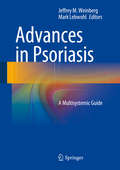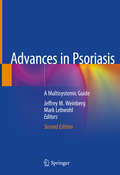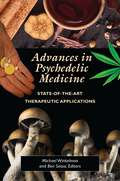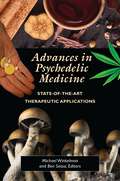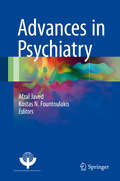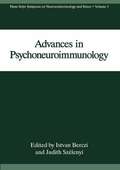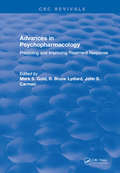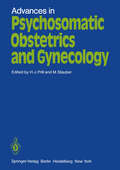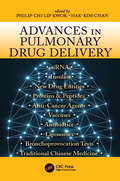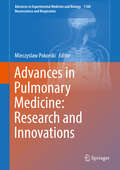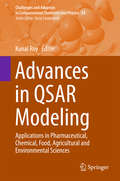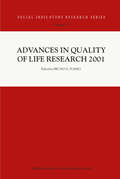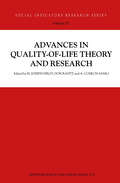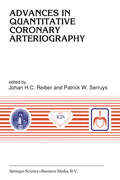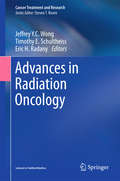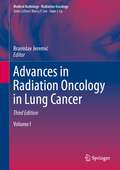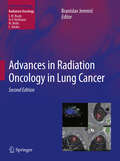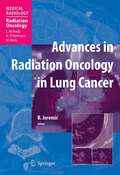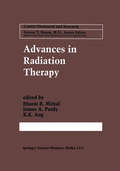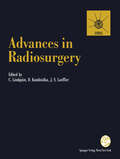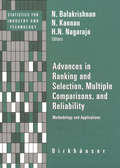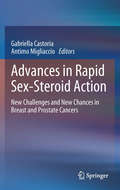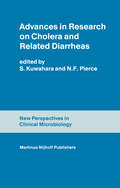- Table View
- List View
Advances in Psoriasis: A Multisystemic Guide
by Jeffrey M. Weinberg Mark LebwohlIt has become increasingly clear that psoriatic disease, both of the skin and joints, can be a significant diagnostic and therapeutic challenge for the physician and a debilitating illness for the patient. Genetic and immunologic advances have increased our understanding of the pathophysiology of psoriasis and psoriatic arthritis and there is a need for practically oriented evidence based references to describe the management options open to clinicians. The speed at which developments are occurring in the field also necessitates a novel approach to keeping up with these changes in practice and the need is for a reference that that be updated regularly as the subject requires. Psoriasis is an incredibly fast-moving discipline within dermatology. Guidelines, treatment options and management all change at incredible speed. There is a requirement to provide a comprehensive reference resource to provide practical, user friendly information for the dermatology profession to aid in the decision-making process. Psoriasis is a graphical subdiscipline of medicine and therefore this will have copious illustrations. As a fast moving discipline the emphasis must be on annual updates to ensure that readers are kept up to date on the important areas of development.
Advances in Psoriasis: A Multisystemic Guide
by Jeffrey M. Weinberg Mark LebwohlThis extensively revised second edition provides an up-to-date and highly informative textbook on psoriasis. The understanding of the mechanisms behind the disease and the available treatment options have continued to develop rapidly in recent times, with this vital resource covering the latest in these management options, including targeted T-cell therapy, the use of immunomodulators, systemic therapies, and ultraviolet and laser therapy. In addition, it provides a detailed overview of the pathophysiology, comorbidities, epidemiology and triggers of the disease. Advances in Psoriasis: A Multisystemic Guide extensively details the scientific basis and practice management of psoriasis. It is therefore a vital resource for practicing and trainee dermatologists looking to develop their clinical knowledge of how to manage and treat these patients.
Advances in Psychedelic Medicine: State-of-the-Art Therapeutic Applications
by Michael Winkelman and Ben Sessa, EditorsResearchers, program administrators, and practicing clinicians explain the most recent developments in using psychedelic substances to treat psychological, physiological, and social problems.More than a decade ago, the U.S. government lifted its ban on all testing of psychedelic substances. Winkelman and Sessa now provide updated scientific research and applications of these substances, now moving into approved categories of medicine. The text is an up-to-date assessment of the latest advances in the field of psychedelic medicine, covering the use of LSD, psilocybin, MDMA, ayahuasca, and other substances to augment psychotherapies for a range of disorders. It discusses medical and psychiatric concerns, clinical efficacy and safety, ethical considerations, and neuroscience findings regarding the psychedelic compounds. Topics covered include an overview of psychiatric applications of psychedelics; treatments for addictions and depressive disorders; effects of psychedelics on inflammation and neuroplasticity; evidence for clinical applications of DMT, ayahuasca, and cannabidiol; psychedelic treatment of sociopathic disorders; microdosing psychedelics; training psychedelic therapists; and community-based harm reduction approaches to managing psychedelic crises.
Advances in Psychedelic Medicine: State-of-the-Art Therapeutic Applications
by Michael J. Winkelman Ben SessaResearchers, program administrators, and practicing clinicians explain the most recent developments in using psychedelic substances to treat psychological, physiological, and social problems.More than a decade ago, the U.S. government lifted its ban on all testing of psychedelic substances. Winkelman and Sessa now provide updated scientific research and applications of these substances, now moving into approved categories of medicine. The text is an up-to-date assessment of the latest advances in the field of psychedelic medicine, covering the use of LSD, psilocybin, MDMA, ayahuasca, and other substances to augment psychotherapies for a range of disorders. It discusses medical and psychiatric concerns, clinical efficacy and safety, ethical considerations, and neuroscience findings regarding the psychedelic compounds. Topics covered include an overview of psychiatric applications of psychedelics; treatments for addictions and depressive disorders; effects of psychedelics on inflammation and neuroplasticity; evidence for clinical applications of DMT, ayahuasca, and cannabidiol; psychedelic treatment of sociopathic disorders; microdosing psychedelics; training psychedelic therapists; and community-based harm reduction approaches to managing psychedelic crises.
Advances in Psychiatry
by Afzal Javed Kostas N. FountoulakisThis book will be the newest edition on the series ‘advances in psychiatry’. The previous 3 volumes can be found online at http://www.wpanet.org/detail.php?section_id=10&content_id=660 . They were highly successful in covering a broad area of psychiatry from different perspectives and angles and by reflecting both specialized but also international and global approaches. This series have guaranteed quality therefore can be used by different scientific groups for teaching and learning and also as a means for fast dissemination of advanced research and transformation of research findings into the everyday clinical practice. There is already a body of readers anticipating the next volume.
Advances in Psychoneuroimmunology (Hans Selye Symposia on Neuroendocrinology and Stress #3)
by I. Berczi Judith Szélenyia
Advances in Psychopharmacology: Improving Treatment Response
by Mark S. GoldThe book focuses on the prediction and optimization of pharmacological treatment of psychiatric patients. Topics covered include the importance of accurate psychiatric diagnosis, medical problems which can mimic psychiatric illness, and the interface between psychiatric illness and opiate addiction and alcoholism. Current literature on predicting responses to antidepressants, lithium, antipsychotics and antianxiety agents is summarized. This practical guide also offers details on the state-of-the-art uses of blood levels in psychiatric practice for each class of drugs as well as other useful information in tables, graphs and flow charts.
Advances in Psychopharmacology: Improving Treatment Response
by Mark S. GoldThe book focuses on the prediction and optimization of pharmacological treatment of psychiatric patients. Topics covered include the importance of accurate psychiatric diagnosis, medical problems which can mimic psychiatric illness, and the interface between psychiatric illness and opiate addiction and alcoholism. Current literature on predicting responses to antidepressants, lithium, antipsychotics and antianxiety agents is summarized. This practical guide also offers details on the state-of-the-art uses of blood levels in psychiatric practice for each class of drugs as well as other useful information in tables, graphs and flow charts.
Advances in Psychosomatic Obstetrics and Gynecology: Proceedings. Sixth International Congress of Psychosomatic Obstetrics and Gynecology, Berlin, Reichstag, September 2 - 6, 1980
by P. G. PechatschekThe Sixth International Congress of Psychosomatic Obstetrics and Gynecology, which took place from 2 to 6 September 1980 in the congressional chambers of the former Reichstag building in Berlin, had as its theme "Women in a Changing Society." Partic ular emphasis was placed on the fact that in illness, as well as in good health, women must be considered in a comprehensive psychosocial context. Observations from medi cal, psychological, sociological, and anthropological perspectives on the healthy and sick woman through the various stages of her life presented a wide spectrum of scien tific research. Sessions covering such fundamental topics as the problems of the young mother, women in the postgenerative phase, and the early mother-child relationship were enriched by many recent scientific contributions. Further subjects, ranging from the dialogue in the gynecologist's consulting room through the emotional situation of the gynecologist, body language in female sexuality, and sexual disorders experienced by gynecological patients to psychosomatics and cancer, were pursued in small workshops. Of particular psychoendocrinological interest were the contributions on obesity and the premenstrual syndrome. The results of this workshop and another on unwanted pregnancy have ap peared recently in separate monographs.
Advances in Pulmonary Drug Delivery
by Philip Chi Lip Kwok Hak-Kim ChanThe respiratory tract has been used to deliver biologically active chemicals into the human body for centuries. However, the lungs are complex in their anatomy and physiology, which poses challenges to drug delivery. Inhaled formulations are generally more sophisticated than those for oral and parenteral administration. Pulmonary drug development is therefore a highly specialized area because of its many unique issues and challenges. Rapid progress is being made and offers novel solutions to existing treatment problems. Advances in Pulmonary Drug Delivery highlights the latest developments in this field.
Advances in Pulmonary Drug Delivery
by PHILIP CHI LIP KWOK AND HAK-KIM CHANThe respiratory tract has been used to deliver biologically active chemicals into the human body for centuries. However, the lungs are complex in their anatomy and physiology, which poses challenges to drug delivery. Inhaled formulations are generally more sophisticated than those for oral and parenteral administration. Pulmonary drug development is therefore a highly specialized area because of its many unique issues and challenges. Rapid progress is being made and offers novel solutions to existing treatment problems. Advances in Pulmonary Drug Delivery highlights the latest developments in this field.
Advances in Pulmonary Medicine: Research and Innovations (Advances in Experimental Medicine and Biology #1160)
by Mieczyslaw PokorskiThis book discusses a wide range of investigations and practice-oriented advances in pulmonary medicine and critical care. Pulmonary diseases are a major cause of hospitalization and mortality, affecting millions of people worldwide. Addressing a range of topics, including chronic obstructive pulmonary disease, sleep apnea, and lung cancer, the book offers insights into the disease mechanisms and risk factors, along with practical aspects concerning the maintenance of quality of life, adherence to therapy, and palliative treatment and care. Further, it explores diagnostic and treatment approaches to respiratory dysfunction and respiratory failure, highlighting the beneficial effects of good sleep quality in chronic pulmonary conditions and lung transplant patients. The book also presents novel experimental research on the cellular voltage-gated sodium channels in the mechanism of pathological cough, which is particularly relevant for future targeted antitussive therapy. Lastly, it addresses the epidemiological aspects of pulmonary infections. As such, this book is a valuable resource for medical scholars, clinicians, family physicians, and other professionals seeking to improve the management of respiratory diseases.
Advances in QSAR Modeling: Applications in Pharmaceutical, Chemical, Food, Agricultural and Environmental Sciences (Challenges and Advances in Computational Chemistry and Physics #24)
by Kunal RoyThe book covers theoretical background and methodology as well as all current applications of Quantitative Structure-Activity Relationships (QSAR). Written by an international group of recognized researchers, this edited volume discusses applications of QSAR in multiple disciplines such as chemistry, pharmacy, environmental and agricultural sciences addressing data gaps and modern regulatory requirements. Additionally, the applications of QSAR in food science and nanoscience have been included – two areas which have only recently been able to exploit this versatile tool. This timely addition to the series is aimed at graduate students, academics and industrial scientists interested in the latest advances and applications of QSAR.
Advances in Quality of Life Research 2001 (Social Indicators Research Series #17)
by BrunoD. ZumboThe knowledge base in the domains of quality of life, well-being, and subjective well-being is continuing to grow at a rapid rate. In light of this growth, and the interest it reflects on the part of scholars, practitioners, and policy makers internationally, this book will play an important role in bringing scholars and students up to date on diverse topics and promoting and encouraging research in the field of quality-of-life (QOL) studies. Unlike most other similar publications quality of life studies is broadly construed to involve all of the social and health sciences. This volume has much to offer the reader. The papers reflect a diversity of disciplinary and methodological perspectives, it contains material on (a) the monitoring, assessing, and modelling of quality of life, (b) matters of policy, finance, marketing, and business, and (c) papers devoted to the determinants and correlates of well-being and quality of life.
Advances in Quality-of-Life Theory and Research (Social Indicators Research Series #20)
by A. CoskunSamli DonRahtz M. JosephSirgyThis volume is relevant to quality-of-life researchers working in the areas of social medicine, sustainable development, social indicators research and health psychology/behavioral medicine. It represents a culmination of programmatic research in the science of QOL. The research methods and conceptual models used are exemplary and can induce QOL researchers to conduct future research in other cultures, geographic areas, and different socio-economic and demographic groups as well as in different QOL domains.
Advances in Quantitative Coronary Arteriography (Developments in Cardiovascular Medicine #137)
by Johan H. C. Reiber Patrick W. SerruysIn this fourth book in the series on quantitative coronary arteriography (QCA) with the earlier three volumes published in 1986, 1988 and 1991, the latest developments in this exciting field are covered. Both the methodolog ical and clinical application aspects of these advances are presented in a comprehensive manner in a total of 37 chapters by world renowned experts. The book is subdivided into a total of eight parts, beginning with the more methodological issues, such as QCA and other modalities (3 chapters), cine film versus digital arteriography (3 chapters), quality control in QCA (4 chapters), and coronary blood flow and flow reserve (3 chapters). Since QCA has been well established as the technique for the assessment of regression and progression in atherosclerotic disease, and of restenosis after recanaliz ation procedures, major clinical trials in both groups are described extensively by their principal investigators in a total of 11 chapters. In addition, the QCA results after the application of various recanalization techniques are presented in another eight chapters. In the last part the experiences with various intracoronary prostheses with the emphasis on QCA are discussed in five chapters. This large increase in application oriented chapters means that QCA is well alive and gaining momentum. Although the accuracy and precision of the analytical methods steadily improve with the increasing complexity of the algorithms, there is still always the human factor involved in these processes in terms of frame selection, segment definition, etc.
Advances in Radiation Oncology (Cancer Treatment and Research #172)
by Jeffrey Y.C. Wong Timothy E. Schultheiss Eric H. RadanyThis book concisely reviews important advances in radiation oncology, providing practicing radiation oncologists with a fundamental understanding of each topic and an appreciation of its significance for the future of radiation oncology. It explores in detail the impact of newer imaging modalities, such as multiparametric magnetic resonance imaging (MRI) and positron emission tomography (PET) using fluorodeoxyglucose (FDG) and other novel agents, which deliver improved visualization of the physiologic and phenotypic features of a given cancer, helping oncologists to provide more targeted radiotherapy and assess the response. Due consideration is also given to how advanced technologies for radiation therapy delivery have created new treatment options for patients with localized and metastatic disease, highlighting the increasingly important role of image-guided radiotherapy in treating systemic and oligometastatic disease. Further topics include the potential value of radiotherapy in enhancing immunotherapy thanks to the broader immune-stimulatory effects, how cancer stem cells and the tumor microenvironment influence response, and the application of mathematical and systems biology methods to radiotherapy.
Advances in Radiation Oncology in Lung Cancer (Medical Radiology)
by Branislav JeremićThis is the third, completely updated edition of a comprehensive book in which many of the world’s leading lung cancer specialists discuss the recent advances in the radiation oncology of lung cancer and reflect on the latest research findings in lung cancer and other intrathoracic malignancies. Lung cancer remains the major cancer killer in both sexes worldwide. It is so despite significant progress in recent decades in both diagnostic and treatment approaches. New biological and technological advances in this field are now faster incorporated in the overall decision-making process and are bringing fast and substantial improvements in both survivals and quality of life of lung cancer patients. Optimized patient-oriented approaches are reality of the third decade of this millennium and thoracic oncologists strive towards nothing but seamlessly delivering it in a continuous battle with lung cancer. The first three sections of the work cover the basic science of lung cancer, clinical investigations, including histology and staging, and a wide range of fundamental treatment considerations. Current treatment strategies for small cell and non-small cell lung cancer as well as other intrathoracic malignancies are then explained and evaluated in detail, with due attention to novel approaches that promise further improvements in outcome. The various types of treatment-related toxicity are discussed, and quality of life studies and prognostic factors are also considered. After evaluating the latest technological and biological advances, including stereotactic radiotherapy, and particle therapy, the book concludes by thorough consideration of specific aspects of clinical research in lung cancer. This concise yet comprehensive book is an invaluable resource for radiation oncologists.
Advances in Radiation Oncology in Lung Cancer (Medical Radiology)
by Branislav JeremicThis is the second, completely updated edition of a comprehensive book in which many of the world’s leading lung cancer specialists discuss the recent advances in the radiation oncology of lung cancer and reflect on the latest research findings. The first three sections cover the basic science of lung cancer, clinical investigations, including histology and staging, and a wide range of fundamental treatment considerations. Current treatment strategies for small cell and non-small cell lung cancer are then explained and evaluated in detail, with due attention to novel approaches that promise further improvements in outcome. The various types of treatment-related toxicity are discussed, and quality of life studies and prognostic factors are also considered. After evaluating the latest technological and biological advances, including IMRT, IMAT, cyber knife treatment, and tomotherapy, the book concludes by thorough consideration of specific aspects of clinical research in lung cancer.
Advances in Radiation Oncology in Lung Cancer (Medical Radiology)
by M. Molls Branislav Jeremic L. W. Brady H. P. HeilmannAlthough decades of laboratory and clinical research have led to incremental improvement in treatment outcome, lung cancer remains one of the most deadly diseases. This volume is unique in being devoted solely to the radiation oncology of lung cancer, and will be of great value to all who are involved in the diagnosis and treatment of the disease. Both non-small cell and small cell lung cancer are considered in detail. Current state-of-the-art treatment strategies and novel approaches that promise further improvements in outcome are explained and evaluated, with the aid of high-quality illustrations. Treatment-related toxicity is discussed, and further individual chapters focus on topics such as quality of life studies, prognostic factors and pitfalls in the design and analysis of clinical trials.
Advances in Radiation Therapy (Cancer Treatment and Research #93)
by K. K. Ang James A. Purdy Bharat B. MittalRecent advances in radiation oncology have depended upon and are intertwined with subsequent scientific discoveries and the development of new techniques in the fields of radiation and molecular biology, physics, electrical engineering, surgery, and medical oncology. This volume describes how some of the recent discoveries in the radiological sciences have influenced the way radiation oncology is practised. As there are many advances in this field, the Editors have chosen to concentrate on selected topics in clinical radiotherapy, radiation physics and biology, and technical innovations that have had a major impact on radiation oncology in the past twenty years. It is hoped that the techniques described in this volume will increase tumor control and prolong patient survival and at the same time decrease radiation-induced side effects and complications.
Advances in Radiosurgery: Proceedings of the 1st Congress of the International Stereotactic Radiosurgery Society, Stockholm 1993 (Acta Neurochirurgica Supplement #62)
by Jay S. Loeffler DouglasKondziolka ChristerLindquistAdvances in Ranking and Selection, Multiple Comparisons, and Reliability: Methodology and Applications (Statistics for Industry and Technology)
by N. Balakrishnan Nandini Kannan H. N. NagarajaS. Panchapakesan has made significant contributions to ranking and selection and has published in many other areas of statistics, including order statistics, reliability theory, stochastic inequalities, and inference. Written in his honor, the twenty invited articles in this volume reflect recent advances in these areas and form a tribute to Panchapakesan’s influence and impact on these areas. Featuring theory, methods, applications, and extensive bibliographies with special emphasis on recent literature, this comprehensive reference work will serve researchers, practitioners, and graduate students in the statistical and applied mathematics communities.
Advances in Rapid Sex-Steroid Action: New Challenges and New Chances in Breast and Prostate Cancers
by Gabriella Castoria and Antimo MigliaccioBreast and prostate cancers are both hormone-dependent, at least in some stages of their progression. Hormonal manipulation represents an important therapeutic approach. Although most of breast and prostate cancers initially respond to hormone therapy, most tumors reinitiate to growth. Finally, hormone-resistant and metastatic breast and prostate cancers may develop. Thus, the challenge is the dissection of mechanisms by which steroid receptor signaling pathways continue to influence cell growth and invasiveness. Compelling evidence indicates that steroid hormones elicit non-genomic responses in extra-nuclear compartment of target cells. In this cellular location, steroid-coupled receptors rapidly recruit signaling effectors or scaffold proteins and activate multiple pathways leading to proliferation, survival, migration and invasiveness. The immediate challenge is the dissection of key events regulating the steroid response of target tissues to prevent progression and improve treatment of breast and prostate cancers.
Advances in Research on Cholera and Related Diarrheas (New Perspectives in Clinical Microbiology #6)
by S. Kuwahara N. F. PierceThe United States-Japan Cooperative Medical Science Program was initiated in 1965 by joint agreement between the President of the United States and the Prime Minister of Japan. The purpose of the Program was to promote cooperative biomedical research between the two countries, especially on health problems of recognized impor tance in Asia. Cholera was designated as one topic of mutual interest. Panels of scientists from each country were formed, and these met to select priority areas for research. The Cholera Panels initially defined two major goals: 1) improved and simplified therapy for cholera, and 2) better methods for immunization. Progress in the pursuit of these goals led to the recognition that bacteria other than Vibrio cholerae are also important causes of acute dehydrating diarrhea which resembles cholera in its manifestations and patho genesis; most notable among these are enterotoxinogenic strains of Escherichia coli. Accordingly, panel guidelines were expanded to include all diarrheal diseases that involve fluid loss caused by an enterotoxin. More recently, studies have shown that vibrios, including V. cholerae, have a distinct environmental life cycle that is probably an impor tant factor in the epidemiology of vibrio infections. For this reason, the panel guidelines were again expanded to include studies on the environmental ecology of vibrios. A major project of the Joint Cholera Panels has been the organization and spon sorship of an annual conference on cholera and related diarrheal diseases.
